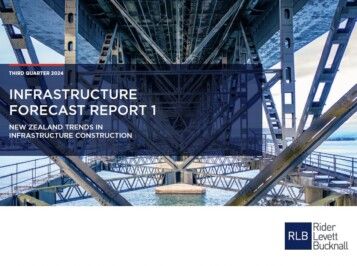According to Rider Levett Bucknall’s (RLB) Inaugural Infrastructure Forecast report – New Zealand Trends in Infrastructure Construction – infrastructure construction had previously ramped up in response to strong population growth, which in turn increased civil construction costs and impacted projects.
However, inflation has declined since 2023, and with higher interest rates having their intended impact in dampening demand, cost pressures in the New Zealand economy are easing in 2024.
We are proud to launch the first edition of the RLB Infrastructure Forecast report – New Zealand Trends in Infrastructure Construction, where key developments in infrastructure construction are analysed to indicate the construction outlook ahead including forecasts for cost inflation.
RLB Director Ed Cook
“Prepared by the New Zealand Institute of Economic Research (Inc.) (NZIER) exclusively for Rider Levett Bucknall (RLB), the outlook for infrastructure construction costs is determined by key drivers on both the demand (infrastructure investment, macroeconomic environment) and supply side (availability of labour and building materials),” he said
According to the report, activity indicators such as ready-mixed concrete production signal softer construction activity more broadly, which in turn is alleviating cost pressures. Softer demand has led to lower prices in civil construction materials. Similarly, steady global steel production has helped ease infrastructure construction cost pressures, which is positive for New Zealand’s construction sector.
NZIER’s Quarterly Survey of Business Opinion (QSBO) shows that the construction sector is still very downbeat regarding the economic outlook. This pessimism reflects continued weak construction demand, with building sector firms reporting a decline in output and new orders. This is weighing on pricing power and, in turn, profitability in the construction sector.
Ed continued, “Despite these challenges, the infrastructure investment outlook presents a more positive narrative. Te Waihanga, the New Zealand Infrastructure Commission, reported in its Pipeline snapshot that infrastructure projects totalled $121.2 billion in March 2024. Of this, around $44 billion is estimated to be under construction and $11 billion in procurement.”
“The main sectors driving this investment pipeline include transport and water infrastructure. The Government announced at the beginning of September nearly $33bn of transport investment over three years to reintroduce the Roads of National Significance (RoNS) programme, a focus on maintenance of existing assets and further funding for public transport initiatives,” he said.
Building Costs
Rider Levett Bucknall commissioned NZIER to produce a framework for forecasting a measure that tracks infrastructure construction cost changes. While there is published information on construction costs relating to infrastructure construction from a variety of sources, including Waka Kotahi, what has been lacking is forecasts of infrastructure construction cost inflation.
Part of this reflects the large-scale and specific nature of infrastructure projects, which means that it is difficult to determine an index that is more broadly representative of cost changes in infrastructure construction.
Another reason is the lack of forecasts of the inputs that go into composite indices that are compiled to capture past movements in various types of infrastructure construction costs.
RLB have developed a forecast for a representative index of infrastructure construction costs based on 1) the inputs we found to have a significant influence on infrastructure construction costs and 2) the availability of forecasts of these inputs themselves.
Ed concluded, “RLB expects construction cost inflation will stabilise at lower levels over the coming years, reflecting ongoing relief from capacity pressures in the infrastructure sector.
“Our CGPI-Civil Index forecasting model, which incorporates various inputs, indicates a continued easing of labour cost inflation. Moreover, consensus forecasts predict a near-term decrease in oil prices and a similar trend for commodity prices over the next few years.”
“The forecasted stabilisation in construction cost inflation is also evident in other indicators, such as the NZIER’s QSBO. Building sector firms report a continued easing in labour shortages. In particular, unskilled labour is now easier to find. The drop in pricing indicators reported by firms in the NZIER QSBO points to further easing on construction cost inflation over the coming year.”
“We forecast annual civil construction cost inflation will ease to around 1.3 percent by the end of this year. Beyond that, we expect civil construction cost inflation to fluctuate around 1.5 to 2 percent over the medium term, as strong migration-led population growth underpins stronger demand for infrastructure construction later in the projection,” he said.
FURTHER INFORMATION:



